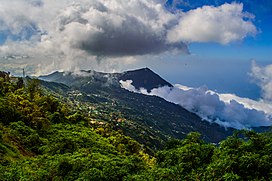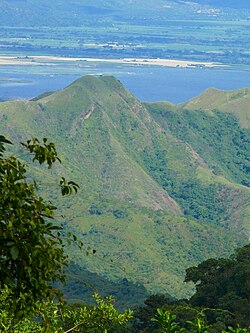Venezuelan Coastal Range: Difference between revisions
DivermanAU (talk | contribs) add wstitle, volume and page to EB1911 template |
|||
| (20 intermediate revisions by 15 users not shown) | |||
| Line 1: | Line 1: | ||
{{Short description|Mountain range in Venezuela}} |
|||
{{Geobox|Brown |
|||
{{Infobox mountain |
|||
| name = Venezuelan Coastal Range<br>Caribbean Mountain System<br>Maritime Andes |
| name = Venezuelan Coastal Range<br>Caribbean Mountain System<br>Maritime Andes |
||
| other_name = Cordillera de La Costa<br>Sistema Montañoso Caribe<br>Andes Maritimos |
|||
| other_name = |
|||
| category = Geographic/Natural Region |
|||
| etymology = |
|||
| ⚫ | |||
| native_name = |
|||
| ⚫ | |||
| native_name_lang = |
|||
| image_size =250 |
|||
| ⚫ | |||
| country = [[Venezuela]] |
|||
| ⚫ | |||
| state = [[Yaracuy]] |
|||
<!-- map --> |
|||
| state1 = [[Carabobo]] |
|||
| map = |
|||
| state2 = [[Aragua]] |
|||
| ⚫ | |||
| state3 = [[Miranda (state)|Miranda]] |
|||
| map_size = |
|||
| state4 = [[Vargas (state)|Vargas]] |
|||
| ⚫ | |||
| state5 = [[Capital District (Venezuela)|Capital District]] |
|||
| location = Central North Venezuela |
|||
| state6 = [[Anzoátegui]] |
|||
| label = |
|||
| state7 = [[Sucre (state)]] |
|||
| label_position = |
|||
| state8 = [[Monagas]] |
|||
| |
| highest = [[Pico Naiguatá]] |
||
| elevation = |
|||
| state10 = [[Cojedes (state)|Cojedes]] |
|||
| elevation_m = 2765 |
|||
| state11 = |
|||
| |
| elevation_ft = |
||
| |
| elevation_ref = |
||
| prominence = |
|||
| ⚫ | |||
| |
| prominence_m = |
||
| |
| prominence_ft = |
||
| prominence_ref = |
|||
| highest = Pico Naiguatá |
|||
| isolation = |
|||
| highest_elevation = 2,765 |
|||
| isolation_km = |
|||
| lowest = Caribbean lowlands |
|||
| |
| isolation_mi = |
||
| |
| isolation_ref = |
||
| |
| parent_peak = |
||
| listing = |
|||
| area = 48,866 |
|||
| |
| translation = |
||
| |
| language = |
||
| pronunciation = |
|||
| ⚫ | |||
| range = |
|||
| ⚫ | |||
| ⚫ | |||
| website = |
|||
| coordinates_ref = |
|||
| topo = |
|||
| type = |
|||
| age = |
|||
| geology = |
|||
| easiest_route = |
|||
| normal_route = |
|||
| access = |
|||
| child = |
|||
| embedded = |
|||
}} |
}} |
||
| ⚫ | The '''Venezuelan Coastal Range''' ({{ |
||
| ⚫ | The '''Venezuelan Coastal Range''' ({{langx|es|Cordillera de la Costa}} or {{lang|es|Serranía de la Costa}}), also known as '''Venezuelan Caribbean Mountain System''' ({{langx|es|Sistema Montañoso Caribe}}), is a [[mountain range]] system and one of the eight [[natural regions of Venezuela]], that runs along the central and eastern portions of [[Venezuela]]'s northern coast. The range is a northeastern extension of the [[Andes]], and is also known as the ''' Maritime Andes'''. It covers around 48,866 km<sup>2</sup>, being the 4th largest natural region in Venezuela. |
||
==Geography== |
==Geography== |
||
[[Image:Wikipedia Cordillera de la Costa.JPG|thumb|left|250px|Coastal Range of Venezuelan Andes from biological station Rancho Grande]] |
[[Image:Wikipedia Cordillera de la Costa.JPG|thumb|left|250px|Coastal Range of Venezuelan Andes from biological station Rancho Grande]] |
||
| ⚫ | The Coastal Range |
||
| ⚫ | The Coastal Range consists of two parallel ranges, which run east and west along the coast of the [[Caribbean Sea]]. The [[Cojedes River]] separates the western end of the Coastal Range from the [[Cordillera de Mérida]] to the southeast. The range is divided into eastern and western sections by the wide bay between Cape Codera and [[Cumaná]]. |
||
| ⚫ | |||
| ⚫ | In eastern section of the range, the parallel ranges are known as the Serranía del Litoral, which runs along the Caribbean coast, and the Serranía del Interior to the south. The valley between these two ranges, which includes [[Lake Valencia (Venezuela)|Lake Valencia]], the valleys of metropolitan [[Caracas]], and the [[Tuy River]] at its eastern end, is the most densely populated region of Venezuela. |
||
| ⚫ | |||
| ⚫ | In the eastern section of the range, the parallel ranges are known as the Serranía del Litoral, which runs along the Caribbean coast, and the Serranía del Interior to the south. The valley between these two ranges, which includes [[Lake Valencia (Venezuela)|Lake Valencia]], the valleys of metropolitan [[Caracas]], and the [[Tuy River]] at its eastern end, is the most densely populated region of Venezuela. |
||
The [[Capital District (Venezuela)|Capital District]] lies in a valley between two branches of the Serranía del Litoral: with Cerro El Ávila (peak) and [[El Ávila National Park]] in the [[Cordillera de la Costa Central]] to the north, and smaller hills to the south. |
The [[Capital District (Venezuela)|Capital District]] lies in a valley between two branches of the Serranía del Litoral: with Cerro El Ávila (peak) and [[El Ávila National Park]] in the [[Cordillera de la Costa Central]] to the north, and smaller hills to the south. |
||
| Line 52: | Line 63: | ||
==Ecoregions== |
==Ecoregions== |
||
The lower elevations of the mountains are mostly covered by the [[La Costa xeric shrublands]] [[ecoregion]] of the [[ |
The lower elevations of the mountains are mostly covered by the [[La Costa xeric shrublands]] [[ecoregion]] of the [[deserts and xeric shrublands]] [[biome]]. The [[Araya and Paria xeric scrub]] occupies the arid zones of the Araya and Paria peninsulas, except the montane areas of the Paria Peninsula, which are included in the La Costa xeric shrublands ecoregion. The Araya and Paria xeric scrub also includes [[Isla Margarita]] and extends south onto the mainland to Cumaná. |
||
At elevations from {{convert|600|-|2675|m|ft}} lie the humid evergreen [[Cordillera de la Costa montane forests]] ecoregion of the montane [[ |
At elevations from {{convert|600|-|2675|m|ft}} lie the humid evergreen [[Cordillera de la Costa montane forests]] ecoregion of the montane [[tropical and subtropical moist broadleaf forests]] biome, which form eleven discontinuous enclaves across the high summits of the eastern and western portions of the range. |
||
==External links== |
==External links== |
||
{{commons category|Venezuelan Coastal Range}} |
|||
* {{WWF ecoregion|name=Araya and Paria xeric scrub|id=nt1301}} |
* {{WWF ecoregion|name=Araya and Paria xeric scrub|id=nt1301}} |
||
* {{WWF ecoregion|name=Cordillera la Costa montane forests|id=nt0117}} |
* {{WWF ecoregion|name=Cordillera la Costa montane forests|id=nt0117}} |
||
| Line 63: | Line 73: | ||
* {{cite EB1911 |wstitle=Venezuela |volume=27 |page=188 |first=Andrew Jackson |last=Lamoureux}} |
* {{cite EB1911 |wstitle=Venezuela |volume=27 |page=188 |first=Andrew Jackson |last=Lamoureux}} |
||
{{-}} |
|||
{{Natural Regions of Venezuela}} |
{{Natural Regions of Venezuela}} |
||
{{Subject bar|Andes|auto=y|d=y}} |
|||
[[Category:Venezuelan Coastal Range| ]] |
[[Category:Venezuelan Coastal Range| ]] |
||
| Line 85: | Line 93: | ||
[[Category:Geography of Cojedes (state)]] |
[[Category:Geography of Cojedes (state)]] |
||
[[Category:El Ávila National Park]] |
[[Category:El Ávila National Park]] |
||
[[Category:Cordilleras]] |
|||
Latest revision as of 17:33, 25 October 2024
| Venezuelan Coastal Range Caribbean Mountain System Maritime Andes | |
|---|---|
 A view of Venezuelan Coastal Range from Galipán | |
| Highest point | |
| Peak | Pico Naiguatá |
| Elevation | 2,765 m (9,072 ft) |
| Coordinates | 10°32′36″N 66°46′57″W / 10.54333°N 66.78250°W |
| Geography | |
| Location | Central North Venezuela |
The Venezuelan Coastal Range (Spanish: Cordillera de la Costa or Serranía de la Costa), also known as Venezuelan Caribbean Mountain System (Spanish: Sistema Montañoso Caribe), is a mountain range system and one of the eight natural regions of Venezuela, that runs along the central and eastern portions of Venezuela's northern coast. The range is a northeastern extension of the Andes, and is also known as the Maritime Andes. It covers around 48,866 km2, being the 4th largest natural region in Venezuela.
Geography
[edit]
The Coastal Range consists of two parallel ranges, which run east and west along the coast of the Caribbean Sea. The Cojedes River separates the western end of the Coastal Range from the Cordillera de Mérida to the southeast. The range is divided into eastern and western sections by the wide bay between Cape Codera and Cumaná.
Serranía del Litoral—Serranía del Interior
[edit]In the eastern section of the range, the parallel ranges are known as the Serranía del Litoral, which runs along the Caribbean coast, and the Serranía del Interior to the south. The valley between these two ranges, which includes Lake Valencia, the valleys of metropolitan Caracas, and the Tuy River at its eastern end, is the most densely populated region of Venezuela.
The Capital District lies in a valley between two branches of the Serranía del Litoral: with Cerro El Ávila (peak) and El Ávila National Park in the Cordillera de la Costa Central to the north, and smaller hills to the south.
Both the Littoral and Interior ranges reappear between Cumaná and the Gulf of Paria to form the eastern section of the Venezuelan Coastal Range. The Littoral range forms the Araya Peninsula to the west and the Paria Peninsula to the east, and extends across the straits known as the Dragon's Mouths to form the Northern Range of the island of Trinidad.
Ecoregions
[edit]The lower elevations of the mountains are mostly covered by the La Costa xeric shrublands ecoregion of the deserts and xeric shrublands biome. The Araya and Paria xeric scrub occupies the arid zones of the Araya and Paria peninsulas, except the montane areas of the Paria Peninsula, which are included in the La Costa xeric shrublands ecoregion. The Araya and Paria xeric scrub also includes Isla Margarita and extends south onto the mainland to Cumaná.
At elevations from 600–2,675 metres (1,969–8,776 ft) lie the humid evergreen Cordillera de la Costa montane forests ecoregion of the montane tropical and subtropical moist broadleaf forests biome, which form eleven discontinuous enclaves across the high summits of the eastern and western portions of the range.
External links
[edit]- "Araya and Paria xeric scrub". Terrestrial Ecoregions. World Wildlife Fund.
- "Cordillera la Costa montane forests". Terrestrial Ecoregions. World Wildlife Fund.
- "La Costa xeric shrublands". Terrestrial Ecoregions. World Wildlife Fund.
- Lamoureux, Andrew Jackson (1911). . In Chisholm, Hugh (ed.). Encyclopædia Britannica. Vol. 27 (11th ed.). Cambridge University Press. p. 188.
- Venezuelan Coastal Range
- Mountain ranges of the Andes
- Mountain ranges of Venezuela
- Natural regions of Venezuela
- Geographical regions of Venezuela
- Geography of Caracas
- Geography of Capital District (Venezuela)
- Geography of Miranda (state)
- Geography of Vargas (state)
- Geography of Aragua
- Geography of Carabobo
- Geography of Anzoátegui
- Geography of Sucre (state)
- Geography of Monagas
- Geography of Guárico
- Geography of Cojedes (state)
- El Ávila National Park
- Cordilleras


